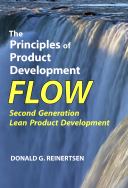UPDATE (04/04/13): Since publishing this blog post, we’ve received input from many on how to improve this presentation and will be publishing a revised version in the near future. Please post any additional feedback you may have in the comments section.
Over the years, there have been many different attempts to translate the Toyota Production System (TPS) into the world of product development. Toyota’s recent struggles in the last few years have tempered some of that, but most still agree that TPS’s “Lean” methods are solid and contain a lot of appropriate logic that R&D can take from their shop floor brethren.
As expected, many of the first attempts at lean product development were a bit shallow, merely offering superficial translations of lean methods and often focusing only on the small and simplistic tools of “waste elimination.” Many books have been published ranging from the “orthodox lean” (that which tries to stay as close to Toyota’s specific methods as possible), through “reformed lean” (that which blends lean principles with similar processes such as “Agile” software development) and finally what we call “hybrid lean” (attempts to graft lean tools onto existing methods). What’s clear from examining these trends is that Lean Product Development can mean many different things depending on who you learn from.
Although it is a few years old now, I created the presentation below, “The Genetics of Lean Product Development” to try and clarify the history of all things claiming the “Lean Product Development” label. Starting with a brief history of lean manufacturing, the presentation goes on to flesh out all the steps that took lean out of the shop floor and a listing of all the major players involved. Today we bring you this presentation through the magic of slideshare.
The biggest mistake made in lean product development is made by those who simply try to copy TPS tools into R&D with no consideration that these two entities operate on different clockspeeds and on a completely incompatible set of economics. It is for this reason that we gravitate closely to the work of Don Reinertsen, whose approach to LPD is finely tuned to the engineering and R&D environment and is grounded in what makes the most sense in terms of cycle time and profitability.
Link:
- 2-Day Workshop: Second Generation Lean Product Development with Don Reinertsen – July 16-17, 2013 in San Diego – Register by May 3, 2013 and SAVE $300


I have participated in a course by Don Reinertsen, and have subsequently sent all my project managers to attend the same course. Have also read the book shown above. Don’s thinking is really excellent in understanding the nature of product development and formulating “lean” principles that can be applied to development.
A great example is how he emphasizes that “waste” often is desired in product development, where we often experience bottlenecks. The understanding that he promotes is the fact that in production, variation is an enemy, whereas in product development, variation is plus. Like the value of a financial option, the more variation you have in the underlying asset price, the more potential profit you can reap. With no variation in development, little innovation happens.
When you desire an underlying variation in your proces, your enemy becomes bottlenecks and delays as a result of these, rather than the direct “waste” in terms of resources. With variation, bottlenecks invariably cause frequent delays because the clog up. The solution is to staff these function so that resources are NOT 100% utilitized. Instead you would want say 70% utilization, incurring a 30% “waste” in traditional lean thinking. But the effect is that you avoid the bottlenecks and keep your development process running.
This is just one example of his thinking. Highly recommended work.
–Morten
Great ideas about designing for lean production, but I’d like to see more on making the customer research and design process itself more lean.
I agree, Glenn. When I originally created this presentation about 4 years ago, I thought someone would be further up that customer research tree by now. Design process efficiency is pretty well covered by Don Reinertsen’s work though.
Wait, wait, wait. Half of what LPD is about seems to be missing from this presentation. The output of product development is useful knowledge, and those who understand that (like Toyota or Al Ward when he was alive) treat PD fundamentally different than a factory. Yes, some of the basic lean ideas and tools are useful, but the real key is creating fast cycles of learning – often through experiments and changing from a task-based, transactional process to a learning objective, knowledge integration methodology. I have used both first-hand and the difference is huge. If you focus first on knowledge growth, you get the efficiency improvements along the way, but if you primarily focus on efficiency, you most often miss the bigger picture knowledge piece.
Brent Wahba
Author: “The Fluff Cycle”